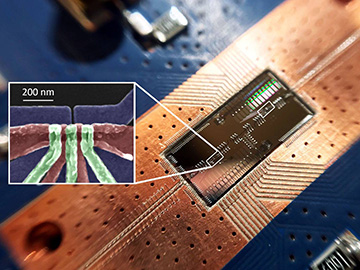
Researchers at Princeton University, USA, have shown how a microwave photon can be used to link up a qubit inside one quantum dot (shown in the inset) with another some 4mm away on a computer chip. Such connectivity will be needed to create the large arrays of qubits inside a working quantum computer. [Image: Felix Borjans]
Given silicon’s pre-eminence in microelectronics, some scientists believe the material is a natural choice when it comes to building quantum computers. Quantum bits, or qubits, made from the spin of single electrons within silicon could in principle be fabricated using techniques similar to those of today’s semiconductor industry, reducing their cost. But it’s hard to link such qubits together and create the large arrays that will be needed if quantum computers are ever to carry out useful tasks.
Now, however, scientists in the United States have shown how microwave photons can be used to connect two silicon qubits over several millimeters—a vast distance in the quantum world (Nature, doi: 10.1038/s41586-019-1867-y). This achievement, they say, should help improve communication between qubits on the same chip, as well as from one chip to another.
Elusive links
Quantum computers can in principle carry out certain tasks exponentially faster than their classical counterparts, as qubits can exist in the states 0 and 1 simultaneously, rather than just one or the other. Many years in the making, such computers’ potential seemed confirmed in October, when researchers at tech giant Google reported having achieved “quantum supremacy”—executing an algorithm that is impossible to simulate in any reasonable time on a classical computer. They did so using a processor containing just 53 superconducting qubits.
However, like all proposed qubit technologies, superconducting circuits have their pros and cons: they’re quick to operate, but have short coherence times, their delicate quantum states lasting for just a few microseconds. In contrast, qubits made from quantum dots—essentially artificial atoms that involve adding a single electron to a nanometer-sized piece of semiconductor—can remain coherent for nearly a tenth of a second. But the difficulty in connecting one such qubit to another makes scaling them up a challenge.
Getting to ties that bind
In the new work, Jason Petta and colleagues at Princeton University have shown how to link spin qubits in two double quantum dots, to create the equivalent of semiconductor molecules. They did so by positioning the dots 4 mm apart at either end of a niobium superconducting cavity on a silicon-and-germanium substrate, and isolating a single electron in each dot.
By applying and varying an external magnetic field, the researchers showed they could individually couple the spin trapped in each quantum dot with a microwave photon in the cavity. Since each spin coupled at a different resonant frequency, the team was able to rule out the possibility that the two spins were simply coupling with one another locally.
Next, Petta and co-workers fixed the value of the external field and varied its angle relative to the sample. In this way they were able to bring the two spins into resonance with the cavity and with each other. This, they write, “is evidence of a long-range interaction between the two spins and a cavity photon.” Such non-local interaction between spins, the authors say, “marks an important milestone for all-to-all qubit connectivity and scalability in silicon-based quantum circuits,” allowing in particular the creation of two-qubit gates between distant spins.
Toward quantum microchips
Group collaborator Thaddeus Ladd, a senior scientist at HRL Laboratories in Malibu, California, underscored the finding’s importance in a Princeton University press release. The experiment, Ladd argues, marks “the first demonstration of entangling electron spins in silicon separated by distances much larger than the devices housing those spins.” Previously, he explains, noise within silicon-based devices had put such long-range interactions between spin qubits in doubt.
The new finding, according to Ladd, “adds substantial flexibility in how to wire those qubits and how to lay them out geometrically in future silicon-based ‘quantum microchips.’”
